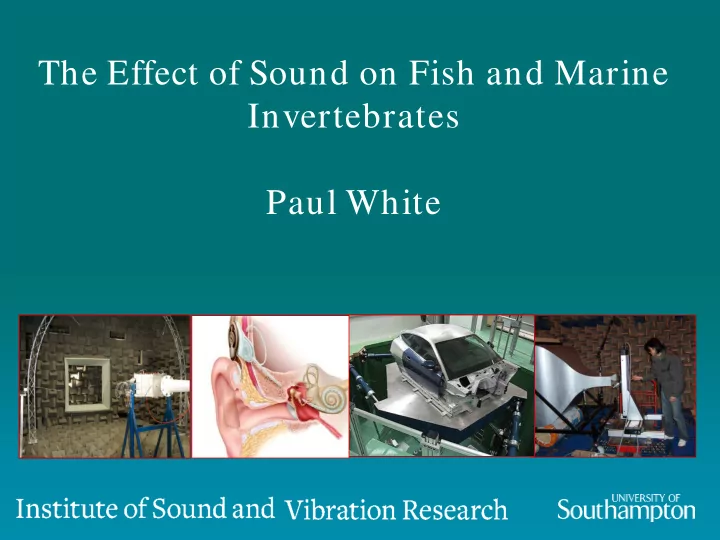

The Effect of Sound on Fish and Marine Invertebrates Paul White
Outline • Introduction/ Update to ISVR • The use of, and problems associated with, sound underwater. • Sound and Anguilliformes (eels and lamprey) • Impact of sound on Marine Invertebrates 2
The University of Southampton London Southampton 3
Academic and administrative structure University of Southampton 8 Faculties Faculty of Engineering and the Environment ISVR (FEE): 4 Academic Units 4
Faculty of Engineering and the Environment (FEE) FEE Consultancy ISVR CMEES AACE Eng. Sci. Education Enterprise Civil Aero. Mech. ISVR ANTC Micro- Structures Consulting fluidics USAIS Academic Units Departments 5
ISVR internal organisation Director: Paul White Deputy HoS Education: Neil Ferguson Research Groups Dynamics: Acoustics Human Sciences Signal Processing David Thompson Phil Joseph David Simpson & Control Group Steve Daley Clinical and Consulting Units USAIS (Uni Soton ISVR Consulting Auditory Implant Service) Malcolm Smith Carl Verschuur 6
Staff and students Consulting Academic Unit and 37 Clinic Research 65 M.Phil./Ph.D. 31 ~ 90 Administrative 2 Graduate M.Sc. Undergraduate ~50 M.Eng./B.Eng./B.Sc. ~130 7
Programmes of Study BE ng/ME ng Acoustical E ngineering (3/4 years) BS c Acoustics and Music (3 years) BS c Audiology (4 years) MS c S ound and Vibration S tudies (1 year) MS c Audiology (1 year) MP hil/P hD (3 years) E ngD (4 years) – only open to UK students 8
Highlights of Funding Successes • Platform grant + large industrial contract in 3D audio. • The Rolls-Royce University Technology Centre (UTC) in gas turbine noise. • BAe support for Centre for Research in Active Control (CRAC) • Mapping the Underworld • EU Grant on Cochlear modelling 9
Bioacoustics in general • Areas of interest: – How animals hear and produce sound: biometics – The impact of noise on animals – Use of acoustics to study animal behaviour – Use of acoustics to manipulate animals • Species groups commonly considered: – Marine mammals – Birds – Fish – Invertebrates 10
Bioacoustics in ISVR • Topics considered include: – Using dolphins to inspire novel sonar/ radar technologies. – Bat echolocation – Analysis and classification of dolphin whistles – Automated humpback whale song classification – Monitoring owl populations – Sound and fish – Impacts of marine invertebrates 11
Eels (European eel – Anguilla anguilla ) • An IUCN red listed species. – Current recruitment is 1% of pre-1980’s levels. • European Union states that nations must implement an eel management plan. • Eel life cycle (catadromous) 12
What has this to do with acoustics? • The EU require that (at least) 40% of adult eels can return to the sea to spawn. • Eel migration is encumbered by man-made structures and water abstraction sites. • Mechanical screening many not be effective – is an acoustic barrier a viable alternative? 13
+100 dB to convert Eel hearing to “re 1 µ Pa” • Electrophsyiological measurement of an audiogram. • Eels appear to be sensitive to low frequency sounds. Jerko et al., J. Comp. Physio. A, 455-459, 1989 14
On-going work at ISVR • In collaboration with colleagues in the International Centre for Ecohydraulics Research (ICER) based in CMEES (Civil, Maritime and Environmental Engineering Sci Unit) in FEE. • Field measurements of eels around an infra sound source. • Computing electrophysiological and behavioural audiograms for Anguilliformes (eels and lamprey). – Other work in this area includes: schooling behaviour in response to sound, the Lombard effect in fish, the effect of sound on sea-horses, study of pile driving noise, noise mapping and the potential effect on eel migration routes. 15
Field Measurements of Eel Behaviour • Field site is at Longham in Dorset (~30 miles from Soton) on the River Stour. Eel rack (once commercial) Infrasound source 16
Experimental Procedure • The sound field from the source is mapped. • Migrating eels are trapped and acoustically tagged. • They are released upstream of the study site and their movements studied when the infrasound source is on and when it is off. 17
On Off On Off 18
Audiograms of Animals • In general two ways of estimating the audiograms of animals. – Behavioural • Play a sound an look for a measureable response – can be augmented via conditioning – Electrophysiological • Use electrodes to detect the brain activity associated with hearing the sound – e.g. Jerko’s measurement of an eel’s audiogram 19
Eels and Lamprey Behavioural Tests for Anguilliformes 20
Electrophysiological Tests • Based on measuring auditory brainstem responses (ABRs) Electrodes Lamprey 21
Marine Invertebrates • In collaboration with colleagues at the National Oceanography Centre. • The effect of sound on marine mammals and fish has been considered for some time (albeit many questions remain). • The possible effect of noise on benthic invertebrate species has received almost no consideration. • These species form a vital part of the ecosystem. 22
Chosen Species • Venerupis philippinarum (bivalve/ clam) • Am phiura filiform is (brittle star) • Nephrops norvegicus (Norway lobster) 23
Measuring impact of Sound on Invertebrates 24
Metrics • Three conditions, 7 day exposures: – Ambient noise – Impulsive (pile driving) – Continuous Ship • Bioturbation (luminophores) • Glucose and latcose 25
Results • The Amphiura showed no response • Whereas the bivalves and Nephrops did modify their behaviour. – These bivalves reduce activity in response to sound. – Conversely Nephrops increased activity (significantly for continuous sounds and not significantly for impulsive) • The biochemistry did not reveal any significant changes in the glucose or lactate as a result of the exposures. 26
Thank you for listening (unlike the Amphiura) Any questions? 27
Recommend
More recommend